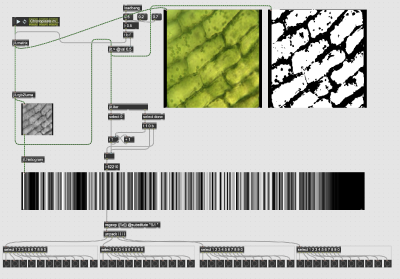GMU:Home Made Bioelectronics/Friedrich Wilhelm Albrecht Pittelkow: Difference between revisions
mNo edit summary |
mNo edit summary |
||
| Line 10: | Line 10: | ||
The data gets processed in Max/MSP. Max is either used for direct sonification or operates as a link to other audio-software (utilizing Midi). | The data gets processed in Max/MSP. Max is either used for direct sonification or operates as a link to other audio-software (utilizing Midi). | ||
[[File:plntseq1.png|400px]] | |||
=== Aesthetic outcome === | === Aesthetic outcome === | ||
Revision as of 10:57, 2 June 2022
Plant based Sequencer
Concept
Often, plants and organisms are built from repeating patterns. But also processes tend to function in patterns such as the transport of nutrients or movements while growing.
These patterns are used to generate rhythms, and combining these create organic growing / evolving (poly)rhythms. The rhythms are used as a musical sequencer, either trigger notes or percussive sounds like a drum machine.
Technical Solution
The measurements of these patterns could be done by and resistance, by amplifying electric/ magnetic fields or by tracking and analyzing video of the cells to the organism.
The data gets processed in Max/MSP. Max is either used for direct sonification or operates as a link to other audio-software (utilizing Midi).
Aesthetic outcome
The outcome of this an installation where the viewer can observe the plants and organisms and listen to the sonification.
References / Research Material
- Rhythms and Morphogenesis - PETER W. BARLOW AND JACQUELINE LÜCK
- [Acoustic and magnetic communication in plants](https://www.tandfonline.com/doi/full/10.4161/psb.21517?scroll=top&needAccess=true)
